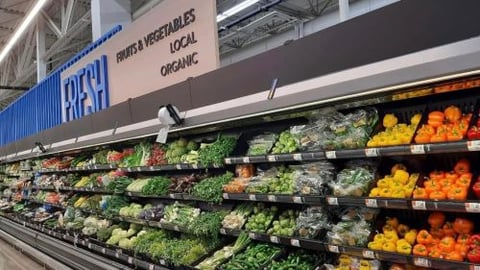From Brand Driver to Commerce Engine
Social Values
- Consumers are discovering products on social media more than on any other channel, with 77% now buying directly through social platforms — a 60% increase in three years.
- More than 75% of consumers say that a brand’s social media reputation matters; 63% believe that it directly affects their purchasing decisions.
- Consumers trust creators as much as or more than traditional brand advertising; 85% have made a purchase based on creator content.
- 59% of consumers discover new products via social media, making it the leading channel for this use case.
- 70% would choose a personalized experience based on their interests, preferences and/or browsing history.
- 33% will spend more when personalization is done properly.
- 78% consider a brand’s reputation on social media to be significant.
- 31% say that they’d spend more when their favorite creator is featured in in-store or online advertising.
Source: Inmar Intelligence
Over the past two decades, social media has become much more than a place to share family photos and personal experiences. Far more interactive and personalized than print and television ads, it is a sophisticated 21st-century marketing tool for purveyors of all shapes and sizes. In 2025, ad spending in the U.S. social media market is expected to reach $95.70 billion; it is forecasted to hit $138.80 billion by 2029, according to Statista.com.
Ads support content, which drives in-store and e-commerce traffic and reinforces brand identity. Content’s role is rapidly changing, however. Retail powerhouses like IKEA, Sephora, Coach, Petco, H&M, and others are generating incremental sales and excitement by letting consumers purchase featured products directly from their social media sites. Statista.com predicts the $75.6 billion U.S. social commerce market will reach $141 billion by 2028. According to Inmar Intelligence, 77% of shoppers purchase directly through social commerce, a 60% increase over three years.
[RELATED: Grocers Focus on Retail Media Networks]
In the United States, 72.5% of the population (246 million people) are active on social media platforms like Facebook, Instagram, TikTok, YouTube and others, research from SEO.ai indicates. Fifty-nine percent find new products via social media, making it the leading discovery channel, Inmar has found. Additionally, according to software company SOTI, 51% say that buying items on social media is a quick, easy way to keep up with trends, while among Gen Zers, it’s 62%. Better digital capabilities, AI and the rising role of online influencers have contributed to social media’s growth.
The social commerce potential for grocery is huge, experts note, particularly when it comes to impulse-driven, limited-availability items, and ones of special interest.
“Social commerce remains a massive, untapped opportunity for the U.S. grocery sector, including traditional supermarkets, discount chains and clubs,” says Brett Narlinger, global head of commerce at Blackhawk Network, a Pleasanton, Calif.-based branded payments provider. “Social platforms have rapidly evolved into powerful search and shopping channels, especially among Millennial and Gen Z consumers. Grocers who invest strategically in social commerce will position themselves to capture new market share and build deeper customer engagement.”
Grocers represent just a fraction of social commerce activity, with Walmart, Albertsons, Kroger and Costco among the handful of U.S. chains that have reportedly dipped their toes in the social commerce waters.
“I’ve seen some trials, but I’m not aware of anybody that’s thrown the tens of millions of dollars at it that you need if you’re serious,” says Matt Hamory, partner and managing director and grocery practice leader at AlixPartners, a New York-based global consulting firm. “In the last five years, execution has been all around Facebook, Instagram and Google ads. The focus has been on influencers, discovery and brand building, but not actual commerce.”
A Powerful Tool
Social commerce’s powers of engagement and pinpointed marketing allow it to merge inspiration and immediate purchasing, giving it advantages over traditional e-commerce, and even targeted texts and emails that shoppers often delete. “Social commerce is both a brand-building engine and a sales driver,” says Stephanie Lopinski, VP, global marketing, at SOTI, in Mississauga, Ontario. “Key advantages lie in personalization, convenience and the ability to drive discovery in a new way that traditional e-commerce doesn’t. Grocers that embrace this channel early can gain a competitive edge in relevance, loyalty and customer lifetime value.”
The visual and interactive components of social media – including influencers, live events and consumer feedback – allow shoppers to see products in action and hear peer feedback, driving trust and impulse purchasing. “Think recipe videos, product demos or limited-time offers,” explains Lopinski. “Social commerce isn’t just a channel. It’s a storytelling and relationship-building opportunity.”
Adds Lee Kallman, chief commercial officer at RDSolutions, a software company in Richmond, Va.: “It’s like a modern informercial. It becomes this other channel where you can get more interactive, with people talking about it. Much time and money goes into a 30-second TV spot. It’s much easier to produce digital content. You can target markets and get so granular, with the algorithms of Instagram or TikTok knowing lots about you. The beauty is that everyone is walking around with a cell phone in their bag or pocket.”
Social commerce is also a viable way to reach young adult shoppers who may elude other media forms. “Social commerce gives grocers a modern, measurable and high-impact way to reach younger, digitally native audiences,” asserts Ranjana Choudhry, SVP of media and data platforms at Winston-Salem, N.C.-based Inmar. “This audience is fickle and difficult to reach.”
By combining social media information with loyalty program data, grocers can customize social commerce offers even more. Loyalty membership isn’t necessary to target shoppers via social commerce, however.
“Many grocers get hung up on loyalty or discount cards,” says Hamory. “On Instagram, I know if a person shops with me or at other places; loyalty says what I bought, and when. Whether you have loyalty data or not, there’s such rich information in the [social media] site and whether they buy directly or don’t.”
Connecting With Consumers
In China, groceries are the top social commerce category, according to McKinsey. Meanwhile, in the United States, groceries aren’t even among the top five, with clothing (43%) dominating, followed by skin care, fashion accessories, body care and hair care (each 30% to 32%). The dilemma for grocery is that most products aren’t super-sexy fast-fashion must-haves that drive impulse buying. Rather, the majority of grocery purchases are driven by replenishment needs, particularly in consumables.
“People aren’t saying, ‘Oh my gosh, I must buy this soft drink now,’” affirms Ross Cloyd, director of retail insights at New York-based Kantar Group. “It’s not like clothing or electronics or a new gadget. In grocery, people buy the same staples. It’s not like, ‘I must have that.’” Serious inflation has also caused food to come “under budget constraints,” adds Cloyd.
At the same time, some CPG brands are successfully using social commerce on a direct-to-consumer basis, generating both online sales and in-store traffic. “Oreo does a fantastic job connecting the brand with shoppers,” notes Cloyd. “They also have special in-store offers.”
Additionally, McCormick partnered with food influencer Tabitha Brown to create a new product called Sunshine Seasoning. By featuring it on social media, the company reportedly generated “record sales.” Teeth-whitening brand Zimba has used Facebook Shops to create a digital storefront where shoppers can discover and purchase products. Procter & Gamble has also sold products via social commerce.
Hot-Item Merchandising
Food dominates many social platforms, making the channel perfect for grocers. “Recipe hacks, ‘haul’ videos and what’s-in-my-fridge-style posts organically drive grocery engagement,” says Choudhry. “Impulse-friendly categories — especially snacks, beverages and seasonal items — are highly suited for scroll-to-cart behavior. Grocers who lean into social commerce can drive measurable business outcomes, from increased sales to brand affinity. Creator content, when paired with data and scaled across digital media, becomes a powerful personalization engine.”
Social commerce may not lend itself to selling an entire weekly grocery basket, however. It’s more about driving sales of new and/or exciting items. “The very nature of grocery is the diversity of what someone might buy every week,” observes Kallman. “Social channels are generally about one thing.”
Some grocery retailers are making the “item” concept work via social commerce. Walmart, for example, is integrating “hot-product” strategies into its omnichannel experiences. The company has teamed with TikTok to stage live shopping events where viewers can snag immediate deals. Its Instagram Shop markets curated items to younger people, linking purchases to in-store pickup.
[RELATED: TikTok, YouTube Influence Frozen Food Purchases]
Meanwhile, in the United Kingdom, Lidl launched a TikTok Shop where it introduced J.D Gross Dubai Style Chocolate, which appeals to young, health-conscious shoppers. Lidl captured consumer interest by leveraging exclusivity and affordability, selling out its entire stock of 6,000 bars at a rate of 72 bars per minute, according to an article on Kantar’s website. Comments on Lidl’s U.K. TikTok site had consumers clamoring for more. “There’s a treasure-hunt component,” says Kallman. “That’s what draws people.”
Foods and beverages addressing special diets and other health concerns could also fit well within the “hot-item” strategy. “Alternatives to alcohol and supporting your liver are huge,” notes Hamory. “There’s a 48-year-old guy losing weight. You could have an offering of Paleo or gluten-free products. Ready-to-eat meal solutions are seeing much investment. There’s also specialty cuisines. They’re done by companies specializing in these things. It’s about reaching out to inform consumers about how products can help play a role in their lives. It’s about connecting people and products. The propositions are massive.”
Recipes also work well, particularly when consumers can purchase ingredients from the social media site. “‘Shop the recipe’ features and short-form videos can inspire purchases directly from the feed,” suggests Lopinski. For his part, Kallman points to the success of The New York Times’ cooking app, which promotes millions of recipes: “With the click of a button, you can put everything in an Instacart basket and have it delivered to you.”
When influencers are involved, recipe posts become even more impactful. “Grocers can collaborate with food influencers to enhance reach and authenticity within the community,” adds Lopinski.
An Inmar survey found that 37% of shoppers say that creators influenced their grocery purchases. “This highlights the power of recipe content meal hacks and authentic lifestyle integration,” says Choudhry. “These categories perform especially well because they fit naturally into the everyday, personal content creators already share. This trust is portable across platforms and into store aisles.”
Looking ahead, experts believe that there’s an opportunity for social commerce to grow in the grocery channel, but somebody must take the first major step. “If companies get serious about putting dollars behind it, I don’t think there’s a structural barrier,” says Hamory. “The return can be very attractive if you have a good strategy. Once the first mover does it and has great success, everyone will want to do it. There’s enormous potential.”
Growth of AI and sophisticated digital tools could take social commerce to an even higher personalized level. “The next wave of social commerce will be defined by personalization, AI and smarter creator selection,” predicts Choudhry. “With first-party data becoming more valuable, grocers have a unique opportunity to build loyalty and shape trends through influencer content powered by real insights — not just reach.”
Top 5 Categories Most Purchased Via Live Commerce in the Past 12 Months
% of live-commerce users
(Source: McKinsey Global Live Commerce Survey, August-September 2022)











